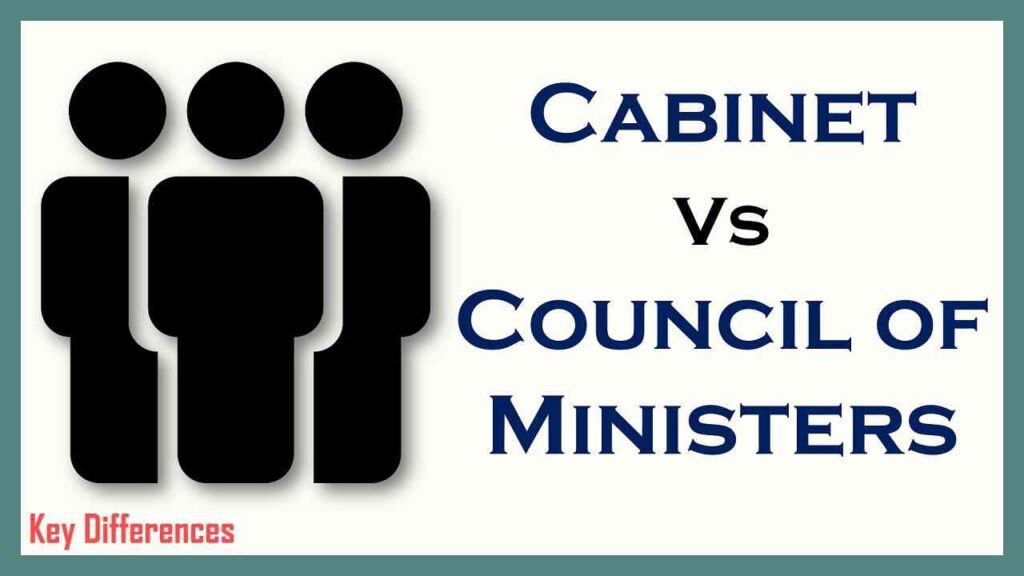
Explore 12 Key Difference between Cabinet and Council of Ministers
Welcome! In this reading, we will explore the fascinating difference between two key bodies in government: the Cabinet and the Council of Ministers. Let’s delve into their roles, functions, and how they shape decision-making processes in various political systems.
12 Difference between Cabinet and Council of Ministers
The difference between the Cabinet and the Council of Ministers is of paramount importance in understanding the functioning of a government. While both these entities play crucial roles in the decision-making process, they possess distinct characteristics that set them apart. Here are 12 key differences that highlight their unique features:
Composition: The Cabinet typically consists of a smaller group of senior ministers chosen by the head of state, many of whom hold important portfolios. On the other hand, a wider range of ministers, including those with smaller portfolios, are represented on the Council of Ministers.
Decision-making power: The Cabinet has more power and frequently has the ability to make important policy decisions. However, the Council of Ministers typically serves as a Cabinet advisory body, offering suggestions and viewpoints.
Principal duties: The Cabinet is in charge of formulating and carrying out government policies as well as directing the work of various ministries. The Council of Ministers, in contrast, concentrates on debating policy issues, offering suggestions, and representing the interests of their respective ministries.
Influence and power: Within the political system, the Cabinet members have more sway and control. While the Council of Ministers plays a more consultative role, they are frequently seen as the key decision-makers.
Hierarchy: The Cabinet is a higher-ranking body in the government, and the most senior ministers are typically among its members. Despite being important, the Council of Ministers occupies a lower position on the hierarchy of authority.
Meetings: The Cabinet holds more regular meetings where pressing and important issues are discussed. The Council of Ministers meets less frequently and focuses primarily on issues of general significance and policy direction.
Confidentiality: Cabinet discussions and decisions are frequently thought of as confidential and are expected to be kept within the Cabinet. On the other hand, meetings of the Council of Ministers are typically less secretive, allowing for a wider dissemination of information.
Collective accountability: The performance and decisions of the cabinet as a whole are accountable to the public. They are responsible collectively. Despite having individual accountability for their respective ministries, the Council of Ministers is not held to the same level of collective accountability.
Ratification of decisions: The formal endorsement of the head of state or government is frequently necessary for major decisions made by the Cabinet. Even though the decisions of the Council of Ministers are significant, such ratification may not always be necessary.
Precedence: The Cabinet typically has the upper hand over the Council of Ministers when it comes to formulating policies and making important decisions. The advice and implementation of policies are more the focus of the Council of Ministers’ role.
Public representation: Cabinet members frequently act as the government’s public face, speaking on its behalf in a variety of forums. Despite being in charge of their ministries, the Council of Ministers might not be as well known to the general public.
Stability: The Cabinet’s membership has a tendency to hold steady over time with few changes. However, the Council of Ministers may undergo more frequent reorganisations, particularly when political or governmental structures change.
In order to fully comprehend the complex interactions of a government, it is essential to be aware of the subtle difference between the Cabinet and the Council of Ministers. Even though the Cabinet has more authority and power to make decisions, the Council of Ministers offers important perspectives and knowledge from various ministries. They work together to create an essential framework for efficient governance and policy implementation.
Also Read: Explore 12 Key Difference between Admission and Confession